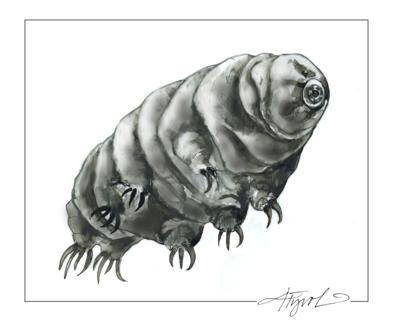The Outside Story: Incredible resilience of water bears
- Elizabeth Crotty The Outside Story
- Jul 9, 2022

Tardigrade aka “water bear” Illustration by Adelaide Murphy Tyrol
When asked to name the most resilient animal, not many people likely think of tardigrades. In fact, most people probably don’t even know tardigrades exist. Affectionately called water bears or moss piglets, these microscopic invertebrates live almost anywhere there is water — from lakes and rivers to the ocean and even in the watery film of terrestrial moss and lichen. And although they might not look like it — with their chubby little arms churning the water on a microscope slide — they are the most resilient animals on Earth.
I became obsessed with these infinitesimal invertebrates during high school. I would collect water from gutters, puddles and the ocean in labeled condiment containers, then sneak into the school’s biology lab where I’d put a droplet of water on a slide and use a microscope to hunt for tardigrades, straining my eyes until I finally found one: an eight-legged, piggish creature with not much of a face, only a hole that passed for a mouth. I was fixated on their existence, losing sleep and focus in the pursuit of knowledge.
If you know nothing of tardigrades, you might ask, “What’s so special about such a miniscule creature?” Well, for starters, they can live in virtually any body of water — from mountain-top pools to the depths of the oceans — even, possibly, on the moon. They thrive on a diet of algae, moss and other small plants.
This diet makes tardigrades good indicators of water and air quality, and scientists use tardigrades as ecological indicators of the condition of their environments. If an area is found to have dead tardigrades — or be absent of them — that might indicate the environment being monitored is polluted. The plants tardigrades eat can absorb pollutants and toxins in the air and water, making them unfit for consumption and leaving the water bears without a viable food source. An environment full of healthy tardigrades, conversely, implies good water and air quality.
Various studies have found tardigrades can survive at altitudes of nearly 20,000 feet and to depths of 15,000 feet. For reference, we humans can only go about 60 feet below the surface of the water before the pressure makes a permanent mark on our health. When taking the layers of the ocean into account, we barely scrape the surface of the topmost — or epipelagic — zone. Tardigrades, on the other hand, are able to dip into the abyssopelagic zone, or the abyss, which lies just above subaquatic trenches, those deep scores on the ocean floor with high pressure, no light and subfreezing temperatures.
Water bears are able to survive at temperatures as low as negative 328 degrees Fahrenheit, which is about 100 degrees shy of the temperature of deep, interstellar space. At the other end of the scale, they can survive in temperatures as high as 300 degrees.
Tardigrades are able to live in such challenging conditions by entering a state called cryptobiosis. This entails retracting all eight of their legs and expelling nearly every drop of moisture from their bodies. Think of it like freeze-drying fruit to keep it edible over time. Tardigrades enter this state when they are faced with a situation that’s too intense, even by their standards — too extreme a temperature, for instance, or too little water. Researchers have found water bears are able to survive for up to 30 years in these conditions. When water is reintroduced to the tardigrade’s environment, or pressure returns to survivable levels, their cells spring back to normal and they resume normal functions.
Scientists have even studied tardigrades in outer space. A privately-funded project, conducted in early 2019, made astronauts out of water bears, sending these tiny beings into space in a lunar lander. The original intent of the project wasn’t deeply scientific; for the most part, it was meant to prove space travel could take place outside of government funding. Unfortunately, the vessel made a crash landing on the moon. There’s a possibility, however, the container housing the tardigrades survived the crash intact, and that the descendants of those tardigrades are still living.
Years after I sat in the dark of a high school lab, bent over the eyepiece of a microscope just hoping to see a tardigrade, I find myself staring up at the night sky — wondering if there are now water bears on the moon.
Elizabeth Crotty is a biology student at Saint Michael’s College in Vermont. The Outside Story is assigned and edited by Northern Woodlands magazine and sponsored by the Wellborn Ecology Fund of the New Hampshire Charitable Foundation.
Re-posted from: The Barre Montpelier Times Argus – https://www.timesargus.com/features/weekend_magazine/the-outside-story-incredible-resilience-of-water-bears/article_c33a6f2b-daf5-5e5d-bf10-7873089b8fbd.html